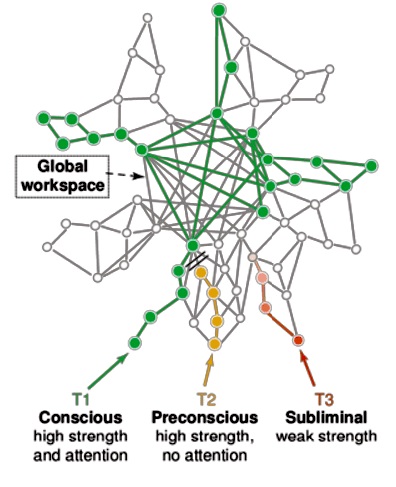Some psychics, mystics and healers access what they call “higher dimensions” by stilling their mind with an image, imagining it clearly, and then a shift occurs – at which time they are able to access “extrasensory” information. My theory is that thoughts, images and memory, as well as chakras and human subtle anatomy, are all extra-dimensional structures – part of the multi-dimensional human. By holding an image in their mind, they shift their thoughts into a higher dimension, possibly creating an extra-dimensional portal in their brain or biofield, which then allows them access to the higher dimensions. These higher dimensions, or extra-dimensions, contain the “extrasensory” information. An Extra-Dimensional Theory would be a step forward in consciousness, healing and parapsychology research. And it would be based on brain microstructure.
In consciousness research, a growing number of scientists support “global workspace” theories of the brain. Conscious, effortful mental activity is global in character, rather than localized to individual areas in the brain (Kelly et al., 2007). Each brain area is connected to a limited number of other areas, and when these connected areas “light up” with activity, then we have a global workspace. Here is a depiction of a neural global workspace from Baar’s book, On Consciousness:

A recent study by the Blue Brain Project suggests that the brain’s global workspace is complex and involves geometric structures and higher dimensions, beyond the 3-D.
Modelling 8,000,000 connections among 31,000 neurons in the rat neocortex in exquisite detail, down to the microscopic dimensions of dendritic trees, the Blue Brain Project team found that the activated connections form geometric structures spanning higher dimensions, typically up to 6 or 7 dimensions, with some reaching the 11th dimension (Reimann et al., 2017). Their study provides the first evidence that brain activity may involve higher dimensions.
Further reading:
Baars BJ (2019) On Consciousness: Science & Subjectivity – Updated Works on Global Workspace Theory. Oxford, MS: Nautilus Press.
Kelly EF et al. (2007) Irreducible Mind: Toward a Psychology for the 21st Century. Lanham, MD: Rowman & Littlefield Publishers, Inc.
News from the Edge, unknowncountry.com: These Dimensions go up to Eleven: Neuroscientists Discover Multi-Dimensional Structures in the Brain